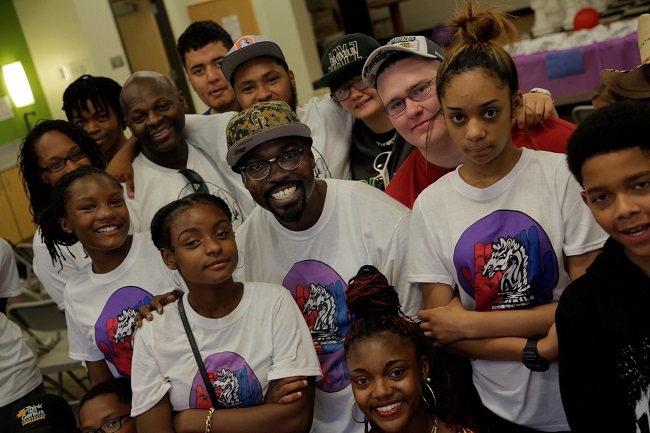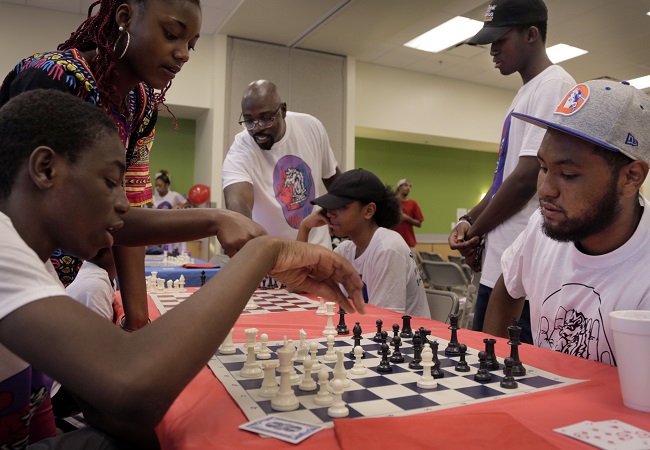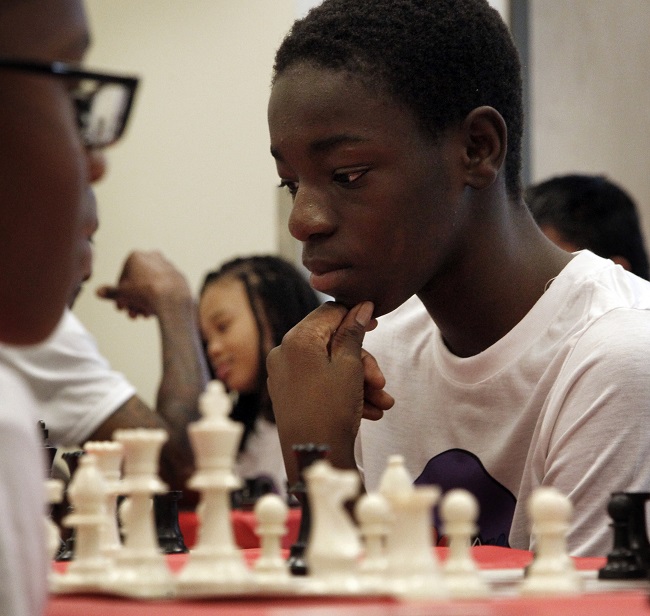
Phillip Douglas (at left) shakes the hand of a student he mentors through Make a Chess Move, a nonprofit that works to empower and educate Denver-area youth by teaching them chess. Photos by Joe Mahoney
Phillip Douglas (at left) shakes the hand of a student he mentors through Make a Chess Move, a nonprofit that works to empower and educate Denver-area youth by teaching them chess. Photos by Joe Mahoney
On Tuesday, June 28, at 2:47 p.m., Jake Williams, executive director of Healthier Colorado, sent out this tweet:
There is an active shooter at the Alliance Center. If you’re one of my colleagues in building, get out.
— Jake Williams (@thisjw) June 28, 2016
Williams had heard a woman scream and felt the building rumble from gunshots one floor below at the Alliance Center, which Healthier Colorado shares with other nonprofit organizations in downtown Denver. The police evacuated the building and put the area on lockdown.
Williams says he felt not only fear but also anger—anger that so many people were put in such a helpless position. In an interview with KUSA-TV, broadcast live shortly after the shooting, he started to say that guns are a public health issue. A reporter quickly cut him off, pressing for more concrete details of the shooting.
It wasn’t until the next day, when the shooter’s intended victim died, that these details became clear. Cara Russell, the former mayor of Buena Vista and executive director of the Colorado Association for Recycling, had been shot by her husband, Mickey, who then killed himself. She had recently filed for divorce.
The power of a random shooting is that it could happen to anyone: Your colleagues, your neighbors, your friends, your family, yourself. Mass shootings like the ones in the Aurora movie theater or Columbine High School in years past have conditioned us to think about escape routes, hiding places, how to keep our kids safe from shooters even in the most mundane settings.
But of course, most shootings aren’t random. They usually have a target, as the killing in the Alliance Center did. Even mass shootings usually single out some family, group or organization—Planned Parenthood staff members in Colorado Springs in November, gay Latinos in Orlando in June.
Two days after Russell was killed, the Alliance Center’s tenants were allowed back in. I spoke to Williams, and asked him what more he wanted to say about guns as a public health issue. Healthier Colorado has never been involved in advocacy on gun issues, and he stressed that the organization doesn’t have a public position. He spoke from his personal perspective, and as the executive director of an organization that advocates for policies that would improve the health of Coloradans.
“You can look at this issue from multiple angles,” Williams says. “And no matter what angle you look at, it’s a public health issue.”
First, he says, there’s mental health. Sometimes, mental illness can contribute to shootings. And certainly in the aftermath, survivors and bystanders often suffer.
Then, adds Williams, “there’s obviously a mortality issue, with the mass dissemination of the means needed to easily kill people. When you look at the United States versus other countries, that variable of availability of firearms is making a big difference in terms of the rate of gun violence.” (Here’s more on that.)
Finally, Williams points out, while the media attention generally focuses on gun deaths by homicide, suicide is more common.
In Colorado, according to a November 2015 report compiled by the Colorado Department of Public Health and Environment, 78 percent of gun deaths are suicides. Suicide attempts are sometimes impulsive; the availability of a gun—lethal and irreversible—can mean the difference between life and death. Indeed, just having a gun in a home is associated with a higher risk of suicide for everybody living there.
If guns are a public health issue, they are also an equity issue.
Suicide disproportionately impacts rural communities in Colorado. The state’s Office of Suicide Prevention has rolled out the Colorado Gun Shop Project in five counties with high percentages of gun-related suicide deaths—Delta, Mesa, Moffat, Montrose and Routt—to educate gun owners and advocates in suicide prevention, and has recommended expanding the program to other counties.
Gun-related homicides, meanwhile, take the lives of black men with terrible regularity. Nationwide, more than 15 black males a day are killed by guns. Nearly 81,000 black men were murdered with firearms between 2001 and 2014, compared to 29,000 non-Hispanic white men; that doesn’t count those shot by police. The wars in Iraq and Afghanistan, by comparison, have taken fewer than 7,000 American lives of any race or gender. Young black men are more than four times as likely as white men of the same age to be murdered with a gun.
In Colorado last year, 30 percent of all murder victims were black. Less than 5 percent of the overall population in the state is black.
The effects reverberate. In some parts of America where rates of violent crime are high, the effect of post-traumatic stress disorder among residents can mimic that of a war zone. Early trauma, including seeing or experiencing violence, can be especially damaging to kids. It can lead immediately to mood disturbances, impulse control problems, difficulty performing in school, and long-term to heart disease, psychiatric, immune or gastrointestinal disorders and other health problems. Gun violence robs life from more than just the victim.
On Friday of that week, in a bright office across from Skyland Park in Denver’s Northeast Park Hill, the leader of a nonprofit called Make a Chess Move pulled out a chess board.
“On this side of Colorado Boulevard are Bloods,” says Phillip Douglas, pointing to the east side of the street. “On this side are Crips.”
Douglas grew up in Crips territory. The brutal economy of the crack epidemic when he was a child seemed to leave room for only the victors and the victims. His father died from alcohol. His mother died from crack. He lived with his grandmother. His cousins and brothers were Crips, and Douglas wanted that life. He wanted the cool shoes, the high living.
The guns were always there. His first memory is as a child of five or six, watching through a closet door as his cousin shot her abusive boyfriend. In 1993, a bullet pierced the skull of his 15-year-old sister, then pregnant with her second child, paralyzing her on one side of the body; she lived until she was 29.
Since then, he’s lost track of how many people he’s known who have been injured or killed by bullets. Too many to count. Maybe 15 in the past year?
Growing up, Douglas doesn’t remember feeling scared. He remembers feeling curious. “You can tell me how hot the stove is. But I wanted to see it for myself,” he says.
Douglas says he never joined a gang, though; his family had other plans for him. He graduated high school in 2002, and went to college for a few years. He also went to prison, swept up in a 2007 gang bust that targeted his cousin, who led a crack cocaine sales ring, and with whom he lived for several years. He says they used to wake up in a huge house in Green Valley Ranch, go to the mall and buy clothes for the day. Just because they could.
He recognizes the same conflicted impulses now in some of the kids with whom he works. His nonprofit trains middle and high school kids to coach younger kids—starting in kindergarten—in chess. Make a Chess Move, or MACM, has brought its curriculum to nine schools so far, says Douglas, with plans to expand to 15 more in the fall.
“Elementary, middle school, high school—that’s when kids experience things,” says Douglas. “That’s when their cousin gets killed, their mom [overdoses on drugs]. Some kids grit it out and graduate high school. That’s what I want to focus on.”
As it has been for Douglas, chess is a way for the kids he works with to deal with stressful events like a friend getting killed, to connect with the community in a healthy way, to think critically.
Ta’Rell Burton was one of his mentees from Manual High School, a kid whose family was well-known to Douglas from the neighborhood. Douglas recruited the teenager to be a trainer for MACM, but never raised enough money to pay him.
About a year ago, when he was 17, Burton posted a photo on Facebook of himself with a pudgy baby attached to his chest in a soft carrier—his son.
“I got that same carry thing,” Douglas posted in an online comment to the photo. “What you know about I had my sons face stuck all in there before I figured out it folds and snaps in front. I had his arms where his head is at, so his arms was raised the whole time. lol I thought I was doing something. Look like you read the manual. I see you. That’s your lane now.”
Burton never got a chance to pick his lane. In March, he was shot dead in Park Hill. Two men, known to the teenager, have been charged with his murder.
“I’ve been doing so much crying,” says Douglas. “I can’t help blaming—it dawned on me that I was blaming Ta’Rell for being out on the street.”
But then he thinks about the way the oppressed get blamed for the system built by the oppressor. And he remembers that Burton was just a teenager, “still battling acne,” says Douglas.
The debate about gun control seems like a lot of noise to Douglas.
“I don’t know how they’re going to get them off the street,” he says. “I know folks who aren’t turning their guns in.”
And anyway, he says, it won’t solve the problem of the gaping racial differences in the graduation rates. In the 2014-15 school year, the black male graduation rate in Colorado was 64 percent. The white male graduation rate was 80 percent. Douglas sees it as all connected—the way schools fail black students, the lack of opportunities outside of gangs, the disenfranchisement.
Beverly Kingston, PhD directs the Center for the Study and Prevention of Violence at the University of Colorado Boulder. The center studies the risk factors for violence, and works to intervene. What her research has found is similar to what Douglas’ life experience has taught him.
“If you have a community all around you that is high poverty, you’re exposed to drugs and violence—that’s going to put you at more risk,” says Kingston. “If we don’t address the root causes of violence, we’re not going to get anywhere.”
Her center leads a project in the Denver neighborhood of Montbello that aims to prevent youth violence. Interventions can start before a child is born—nurse visits to the home of a pregnant or new mother, such as through Nurse-Family Partnership, can help prevent violence later in the child’s life. (The Trust is a past funder of Nurse-Family Partnership in Colorado.) School-based programs to promote alternative thinking strategies and family support can also help, says Kingston.
If you ask Douglas, the solution is chess.
On a Saturday two weeks after I first talked to him, Douglas hosted a chess tournament in Northeast Park Hill for the MACM kids. The room was decorated with balloons in blue, red and purple—signifying the gang colors coming together in unity.
Sir Martin, a MACM co-founder, gave a spoken-word account of why he quit what he called “gang-banging” after starting high school as a Crip.
“Never did I contemplate the consequences or repercussions, such as death or the penitentiary,” he said. “I saw my partner… shot dead and die in these streets.”
Carrying a gun, he said later, makes people less safe, in his experience. And gangs don’t fight for any goal worth achieving.
Douglas’ nephew, Imari Hicks, who is 14, won second place in the tournament. Hicks said the best and most difficult part of chess is trying to get inside the head of the person across the board. It’s like that in life, too, he said.
“I have to think about how people are trying to help me, and understand that,” says Hicks. “And also if people are trying to put me down, how to fight that.”
In the time since I’d last spoken to Douglas, more high-profile gun deaths had shaken the country: the shooting deaths by police of Alton Sterling in Baton Rouge, Louisiana, and Philando Castile in Falcon Heights, Minnesota. And then the shootings of police officers in Dallas and Baton Rouge.
“Violence only begets violence and we are a better country, we are a better people than that,” Denver Mayor Michael Hancock told the city in one of the many public statements of sorrow made after the Louisiana, Minnesota and Texas shootings.
Douglas takes this kind of stuff to his therapist: “It’s traumatic,” he says. He worries about his sons being targeted by police, how to protect them from that; as in the rest of the country, blacks and Hispanics are disproportionately killed by police in Colorado. “There are things you shouldn’t have to do to survive.”
But he added, “I have to worry about cleaning up my own backyard.”
In his “backyard,” kids were lined up across from each other in quiet concentration at alternating red and blue tables, playing round after round of chess.



